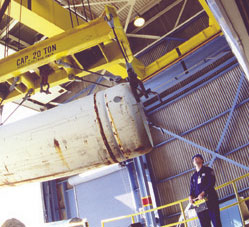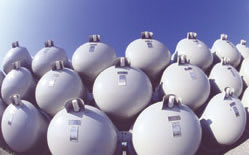Community Profile: Despite Possible Plant Closure, Paducah, Ky., Hopes for an Enriching Future
Nearly since the dawn of the nuclear age, Paducah, Ky., has laid claim to one of the nation's most strategic functions—uranium enrichment. The U.S. government opened the Paducah Gaseous Diffusion Plant in 1952 to manufacture enriched uranium to fuel military reactors and to produce nuclear weapons.
As nuclear power became a more widely used source of energy, the plant changed its mission in the 1960s and began to enrich uranium for commercial reactors to generate electricity.
The plant today is the only uranium enrichment facility in the United States. It employs more than 1,200 people locally. But a need for a new facility using a more efficient method of enrichment has put the future of the Paducah plant in jeopardy. Although one plant official says, "Paducah continues to be the heart of the company's business," the question has arisen, "For how much longer?" As community leaders rally to keep uranium enrichment in Paducah's economic arsenal, they also have begun to seek other prospects.
"It Ain't Over"
The Paducah Gaseous Diffusion Plant is owned by the U.S. Department of Energy and is leased and operated by the United States Enrichment Corp. (USEC). The plant, which competes with companies in other nations, sells nuclear fuel to about one-half the U.S. market and one-third of the world market. While USEC uses the older gaseous diffusion process, its international competitors employ a more efficient centrifuge process to enrich uranium.
USEC recently announced that it will switch to centrifuge technology, which will require building a new facility to replace the existing Paducah operation. That new $1.5 billion, 500-job plant will be located either in Paducah or near USEC's facility in Portsmouth, Ohio, where the company maintains certain operational and administrative functions. USEC will announce its decision next year. Some feel, however, that the handwriting is on the wall, based on the company's decision late last year to build a centrifuge demonstration facility near Portsmouth in the town of Piketon, about 30 miles north.
"The competition seemed more wide open before the test facility announcement," says Georgann Lookofsky, public affairs manager at the USEC plant. "Some people believe that at this point we may be out of the running. But I don't know that for sure. I think it's still a viable competition."
One of Paducah's handicaps is that it sits within the New Madrid seismic zone. The cost to build a new plant in Paducah would be substantially higher than to do so in Ohio because of the need to strengthen the infrastructure to withstand an earthquake.
"That is a hindrance, but it's not an immovable obstacle," Lookofsky says. "You can engineer a building that is seismically sound and adequate, but it does increase the costs and time that you need to deploy operations."
Paducah's economic development officials are not conceding anything yet.
"To borrow a phrase from Yogi Berra, 'It ain't over till it's over,'" says Mark Edwards, outgoing president of the Greater Paducah Economic Development Council. "The next round of proposals will be coming soon, and we intend to be very aggressive with respect to our bid for the full commercial plant," he says, referring to incentives that local, state and federal officials will present to the company.
Says Ken Wheeler, Edwards' successor as chair of the council and head of a local nuclear energy task force: "The Portsmouth announcement was a wake-up call for the community, but we didn't view it in a negative sense. I think it reinforced our efforts to still go after the full-scale centrifuge plant, and we have been doing that very diligently."
Whatever the final decision, the Paducah plant will remain open for at least another eight to 10 years. In fact, USEC in recent years has been consolidating some of its operations in Paducah. The company ceased enrichment operations in Portsmouth in 2001, making Paducah the only production site. Last year, USEC moved its transfer and shipping functions from Portsmouth to Paducah. In addition, the company has spent about $80 million in seismic and security upgrades at the Paducah plant since 1998.
Rivers, Ice Cream and … Cars?
It seems fitting for a place nick-named "Quilt City, USA" (Paducah is home to the National Quilt Museum) to understand that it can't depend on just one company for its vitality, but rather on a patchwork of diverse industries. Although the USEC plant has an enormous economic impact in western Kentucky—by one estimate, second only to the Fort Campbell Army base—other companies maintain a strong presence in and around Paducah.
McCracken County's largest employer, Ingram Barge Co., is one of more than 20 towing companies based in Paducah, which rests on the banks of the confluence of the Ohio and Tennessee rivers.
One of Paducah's most unusual and fastest-growing companies is Dippin' Dots Inc. Its tiny, bead-shaped ice cream is sold at more than 2,000 outlets—including malls, festivals, theme parks and stadiums—in nearly 20 countries. The company is investing $6.5 million in an expansion that will double production capacity and triple storage capacity. With just a handful of employees, Dippin' Dots moved its headquarters and production facility from southern Illinois to Paducah in 1990. Now, the company employs 170 in town.
"Having our home plant in Paducah has certainly served us well over the years," says Terry Reeves, corporate communications director at Dippin' Dots. "The city and county have worked with us on financing construction projects and providing a good work force, utilities, services and transportation."
Economic developers want to attract large manufacturers, too. The region is hoping to join nearby areas like Georgetown, Ky., and Spring Hill, Tenn., in luring an auto manufacturer to town.
To help turn that dream into reality, eight western Kentucky counties—which make up an area known as the Jackson Purchase—have combined to throw their support behind a 4,200-acre industrial park in Graves County, one county south of Paducah.
Bill Beasley, manager of the Purchase Area Regional Industrial Authority Inc., says the eight counties have agreed on a revenue-sharing plan from which they would all benefit if a large company moves to the park.
"When USEC made the announcement that it was going to build the pilot plant in Piketon, it pretty much made the regional industrial park the No. 1 priority for the area," Beasley says.
Beasley adds that the goal is to attract a company that would offer a minimum of 2,000 jobs. He says the industrial authority is in contact with consultants in the site selection business for automotive firms. Although Beasley would not comment on any specific company, the president of one automaker, Mitsubishi, announced in February that his company needs to build a new plant in North America to meet increased demand.
As the Paducah area prepares to embark on an uncertain economic course, the development council's Edwards says that the community is taking a "glass is half full" approach.
"I just can't see us wringing our hands for the next 10 years wondering, 'Oh my gosh, what's going to happen?'" he says. "We are concerned, but we're determined that we're going to overcome. Whether the USEC plant stays or goes, we're prepared for the future."

| Paducah, Ky. By the Numbers |
||
|---|---|---|
| Population |
26,307
|
|
| Labor Force |
11,021
|
|
| Unemployment Rate |
1.5%
|
|
| Per Capita Personal Income |
$18,417
|
|
| Top Five Employers | ||
| Ingram Barge Co. | 2,400 | |
| Lourdes Hospital | 1,600 | |
| Western Baptist Hospital | 1,400 | |
| USEC | 1,200 | |
| McCracken County Schools | 1,000 | |
| NOTES: Population is from 2000. Labor force and unemployment rate are from March 2003. Per capita personal income is from 1999. Employer list represents all of McCracken County. | ||
Views expressed in Regional Economist are not necessarily those of the St. Louis Fed or Federal Reserve System.
For the latest insights from our economists and other St. Louis Fed experts, visit On the Economy and subscribe.
Email Us



